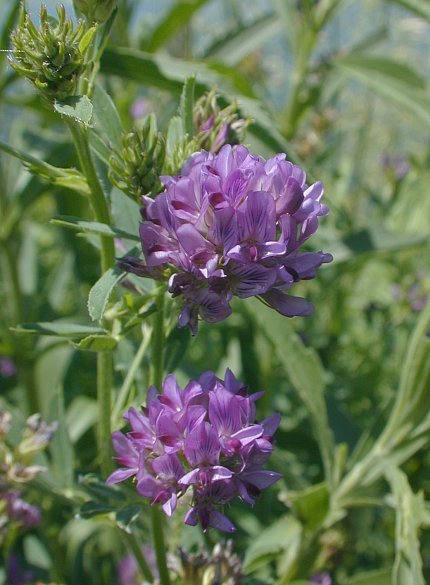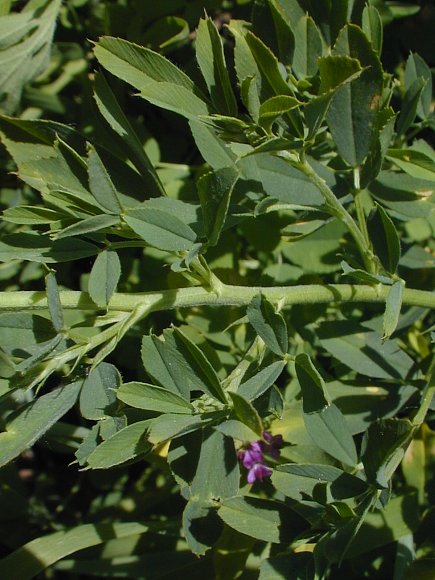Description: This herbaceous perennial plant is 1–2½' tall. A mature plant will tiller from the base, sending up multiple stems that are ascending or erect and branch occasionally. The stems are usually hairless, particularly as they become older. The alternate compound leaves are olive-green and trifoliate. Each leaflet is oblanceolate or obovate, wedged-shaped at the base and nearly truncate at its outer edge. The margin is smooth, except for some dentate teeth along the outer edge. A typical leaflet is about 1" long and 1/3" (8 mm.) across, being wider toward its outer edge than at the base. At the base of each compound leaf, are two small stipules that are lanceolate.

Some of the stems
terminate in short racemes of flowers. The racemes are about ½–2" in
length. Each flower is about 1/3" long, consisting of 5 petals that are
lavender or purple, 10 stamens, a single pistil, and a green calyx. It
has a typical pea-like structure, with a large standard, a keel, and 2
small side petals. However, the standard and keel are somewhat spread
apart, exposing the throat of the flower. The calyx has 5 long teeth,
and it often has scattered white hairs. The blooming period usually
occurs during the summer, and lasts about 1-2 months. However, some
plants may bloom during the late spring or early fall. The flowers are
replaced by tightly coiled seedpods that are about 1/3" in length from
one end to another (they would be longer if uncoiled). They are
flat-sided and have a reticulated surface, sometimes with stiff hairs
along the outer edges. Each seedpod contains several seeds that are
yellowish brown and reniform. The root system consists of a stout
taproot in mature plants. This plant spreads by reseeding itself.
Cultivation:
This species usually grows in full sun in mesic to slightly dry sites
in various kinds of soil. It can tolerate partial sun and moist
locations if there is not too much competition from taller plants. The
leaves are often attacked by various kinds of insects, nonetheless this
plant manages to survive and produce flowers. The root system adds
nitrogen to the soil by forming an association with nitrogen-fixing
bacteria.
Range & Habitat:
Alfalfa is a common plant that occurs in every county of Illinois. It
is often grown in fields by farmers for pasturage and forage. However,
it also has escaped into the wild in both rural and urban areas, where
it can be found in degraded prairies, degraded meadows near rivers and
woodlands, areas along roadsides and railroads, abandoned fields,
vacant lots, and miscellaneous waste areas. This species prefers
disturbed habitats, and it is not a major invader of high quality natural
areas (at least in Illinois). Alfalfa was introduced into North America
from Eurasia for
agricultural purposes.
Faunal Associations:
The nectar of the flowers attracts various kinds of bees, as well as
some small butterflies and skippers. However, the bees are more
effective pollinators. Many kinds of insects feed on the foliage,
flowers, developing seeds, and other parts of Alfalfa (Medicago
sativa). These insect feeders include the larvae of Colias eurytheme (Orange Sulphur) and other Sulphur butterflies, larvae of Everes comyntas (Eastern Tailed Blue) and other Blue butterflies, larvae of Erynnis funeralis (Funereal Duskywing) and other skippers, larvae of Caenurgina erechtea (Forage Looper Moth) and other moths, Melanoplus bivittatus (Two-striped Grasshopper) and other grasshoppers, seed-eating Gryllus pennsylvanicus (Fall Field Cricket), seed-eating adults of Harpalus pensylvanicus (Pennyslvania Ground Beetle) and other ground beetles, larvae and adults of Sitona lepidus (Lesser Clover Leaf Weevil) and other weevils, larvae of Agromyza frontella (Alfalfa Blotch Leafminer) and other leaf-miner flies, Adelphocoris lineolatus (Alfalfa Plant Bug) and other plant bugs, Brochymena quadripustulata (Four-humped Stink Bug) and other stink bugs, Acyrthosiphon kondoi (Blue Alfalfa Aphid) and other aphids, Empoasca alboneura and other leafhoppers, Stictocephala bisonia (Buffalo Treehopper) and other treehoppers, Pseudococcus sorghiellus (Trochanter Mealybug) and other mealybugs, and Frankliniella fusca (Tobacco Thrips). The Insect Table
has a more complete list of these insect feeders. The foliage and/or
seeds of Alfalfa are eaten by the Canada Goose, Sandhill Crane, and
Hungarian Partridge (Martin et al., 1951/1961; Havera, 1999). The
Prairie Vole and Meadow Vole eat the young shoots of this plant, while
the Deer Mouse and White-footed Mouse eat the seeds (Martin et al.,
1951/1961; Hamilton, 1941). Other mammals that feed on Alfalfa include
the Plains Pocket Gopher, Groundhog, and Cottontail Rabbit. Alfalfa is
cultivated as a source of food for domesticated livestock. However, the
foliage can
be mildly toxic if it is eaten in large quantities.
Photographic Location:
A weedy meadow at Judge Webber Park in Urbana, Illinois.

Comments: Alfalfa is one of many introduced legumes. The most distinctive characteristic is its tightly coiled seedpod, whereas most other legumes have seedpods that are more or less straight. The leaflets of Alfalfa are shaped somewhat differently from other legumes, as their coarsely toothed outer tips look like they have been chopped off, while their sides are smooth and wedge-shaped. There is a similar introduced species in the same genus, Medicago falcata (Yellow Lucerne), that has yellow flowers and seedpods that are less tightly coiled. However, it has been observed in only two counties in Illinois. Sometimes Alfalfa is called Purple Lucerne.